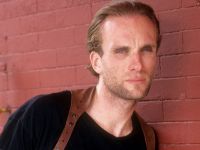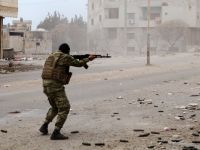Lebanon is nothing if not multicultural. The mixing of French, English and Arabic in one sentence, the mingling of tradition with the trappings of modernity make Lebanon appear unique. There are strong multicultural undertones running beneath the latest group show at Saifi Village’s Alwane Gallery, which includes paintings by Maral Der Boghossian and Louma Rabah, along with the sculptures of Samia Baroudi and Sylvia Dakkak.
Born in 1976, Boghossian mixes traditional Middle Eastern motifs with representations of buildings, landscapes and self-portraits. In her artist’s statement, she explains that “integrating patterns ... is [her way] to give an identity to this urban space which is about to lose its own.”
In her mixed media triptych work “La Ville et les Signes I” (The City and the Signs I), viewers immediately understand Boghossian’s objective. In the foreground of her depiction of a cityscape are a cluster of white triangular objects that resemble the sails of pleasure boats, with the predominant shades of blue punctuated by variations on a theme of yellow.
The scene is deceptively realistic, with traces of rectangular tapestry – each betraying a distinctly Middle Eastern motif – standing in for building facades.
Though there is something slightly suffocating in these juxtaposed layers of color, the effect of the piece is ultimately soothing.
The same approach is evident in another Boghossian triptych, “Inoubliable Ville Multiculturelle” (Unforgettable Multicultural City). Here the layering of architectural and handicraft motifs are supplemented with a trio of stylish angels.
You might assume the work betrays some theological preoccupations on the part of the artist. In fact Boghossian has borrowed these figures from the tradition of Persian and Armenian miniatures. In her artist’s statement, she proposes that the blending of cultures is like the weaving of carpets.
The work of Rabah is also preoccupied with cityscapes, though she seems uninterested in blending traditional and modern motifs and her palette is more exhaustive.
Rabah’s “Maktouaa Bil Hayel Tahtene” (Stranded in the Lower Neighborhood) is a depiction of a city at night. At the bottom of the canvas, the edifices are submerged in darkness – represented in black and azure – while the upper part of the piece is dappled with strong reds, blues, greens and yellows.
Baroudi’s sculptures all work with the theme of the whirling dervish – aka the Mawlawi Sufi in the midst of his dhikr – and the 12 clay works on display here portray dancers or musicians. With one arm directed skyward and billowing skirt, Baroudi’s representation of the dervish is meant to suggests the impression of movement, a challenging task in clay sculpture.
Dakkak’s sculptures are completely different.
Her 20 sculptures represent a dog, woman, donkey or elephant among other figures, all in vivid colors. The irregular application of color gives Dakkak’s work an echo of art naïve.
This collective show is up at Alwane Gallery in Saifi Village until Nov. 21. For more information, please call 01-975-250.








